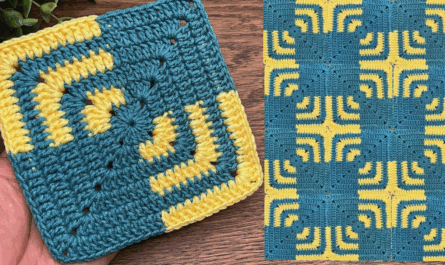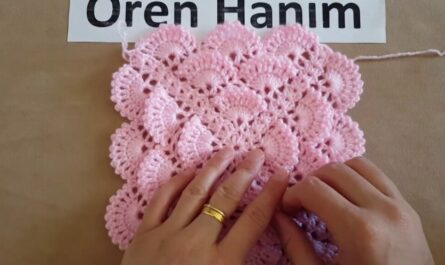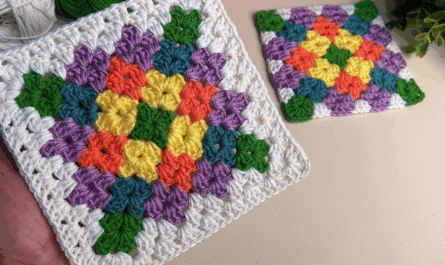Okay, let’s dive into the details of how to crochet a granny square bag! This is a fantastic project that combines the classic appeal of granny squares with the practicality of a functional bag. It’s also an excellent way to use up yarn scraps and create a truly unique accessory.
Given your location in Phnom Penh, where it’s warm, 100% cotton yarn or a cotton blend is an excellent choice for a bag. Cotton is durable, has great stitch definition, and is less prone to stretching out of shape compared to some other fibers, especially for a bag that will carry weight. Plus, it’s breathable, which can be a plus in a warmer climate.
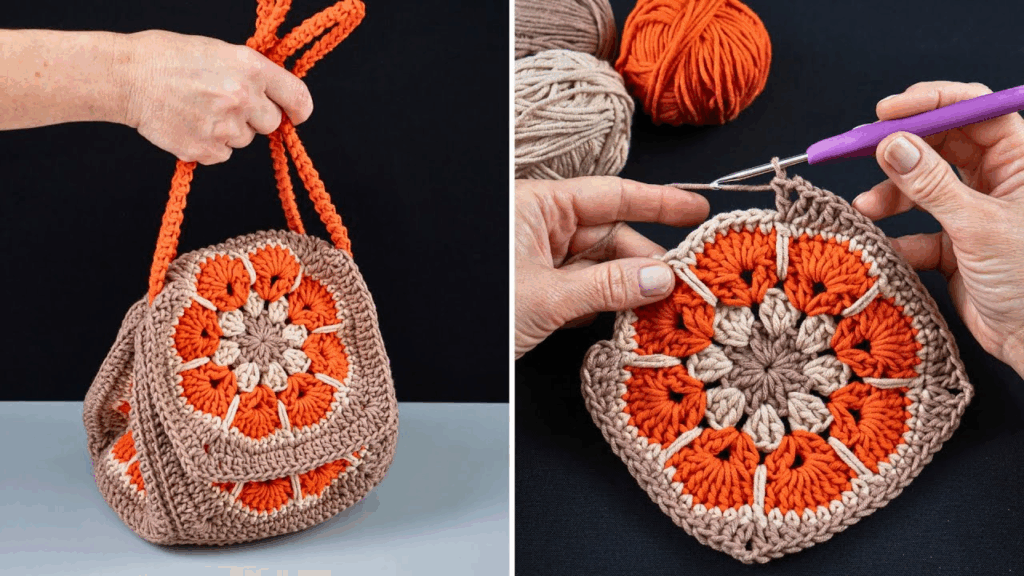
How to Crochet a Granny Square Bag: A Detailed Tutorial
This guide will walk you through creating a simple, classic granny square bag. The process involves crocheting multiple granny squares, joining them together, and then adding a border and handles. An optional lining can also be added for extra durability and neatness.
1. Essential Materials You’ll Need
- Yarn:
- Fiber: 100% Cotton or a Cotton Blend is highly recommended for durability and shape retention. Acrylic yarn also works well, especially if you want a softer drape, but be mindful of its stretch.
- Weight: Worsted Weight (Aran / Medium / Category 4) is a great all-rounder for bags. It works up quickly and creates a sturdy fabric. DK (Double Knitting / Category 3) can be used for a smaller, lighter bag.
- Colors: Get creative! You’ll need a main color (for joining squares, the top border, and the handle) and several contrasting or complementary colors for the granny squares themselves. This is an ideal project for using up yarn scraps!
- Quantity: This will depend on the size of your bag and squares. For a medium-sized tote using 13-16 squares, you might need 200-400g of yarn in total.
- Crochet Hook:
- Choose a hook size appropriate for your yarn weight. For Worsted weight, a 4.0mm (US G/6) or 5.0mm (US H/8) hook is common. A slightly smaller hook will create a denser fabric for a sturdier bag, while a larger one will make a looser, more drapey bag.
- Scissors: For cutting yarn.
- Yarn Needle (Tapestry Needle): Absolutely essential for weaving in ends (and there will be many!) and for securely joining your squares.
- Stitch Markers (Optional but helpful): To mark corners or the start of rounds.
- Measuring Tape: To measure your squares and check the overall bag dimensions.
- Optional for Lining: Fabric for lining (cotton canvas or linen works well), sewing machine or hand-sewing needle and thread, pins.
- Optional for Handle: D-rings, purse hardware, wooden/bamboo handles (if not crocheting a handle).

2. Basic Crochet Stitches & Techniques You’ll Use
You’ll need a solid grasp of basic crochet stitches, particularly those used in classic granny squares:
- Chain (ch): For foundation and chain spaces.
- Slip Stitch (sl st): For joining rounds.
- Double Crochet (dc): The primary stitch for granny squares, forming the “clusters.”
- Magic Ring (MR) / Adjustable Ring: (Optional but recommended) For a tight, hole-free center. Alternatively, a
ch 4, sl st to joinring can be used.
The Classic Granny Square Pattern
This is the fundamental building block of your bag. You’ll make multiple copies of this.
Abbreviations (US Crochet Terms):
- ch: chain
- sl st: slip stitch
- dc: double crochet
- sp: space
- MR: magic ring
(...): work stitches into the same stitch or space[...]: repeat instructions in brackets
Step 1: Crocheting Your Granny Squares
Make as many squares as you need for your desired bag size. A good starting point for a simple tote might be 13 squares (9 for the body, 4 for the bottom). You can also make larger squares (more rounds) for a quicker project, or smaller squares (fewer rounds) for a more intricate look.
To Make One Granny Square (example with 3 colors):
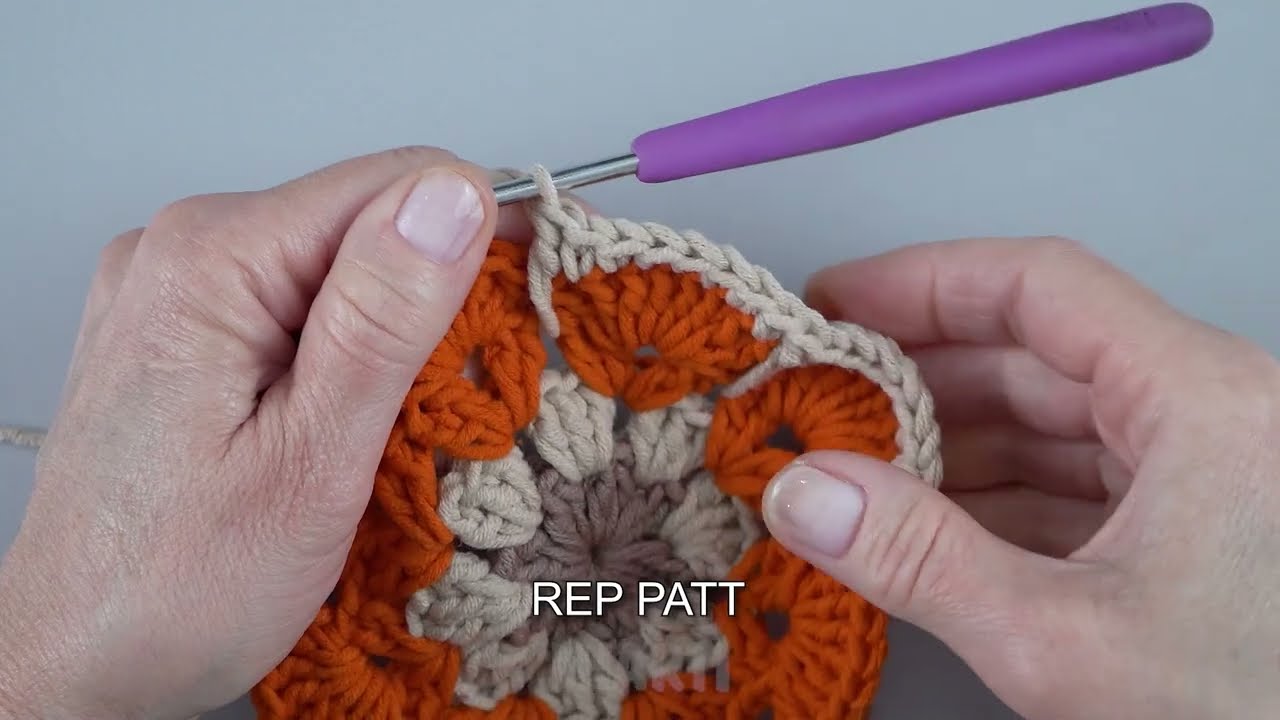
- Start (Color 1): With Color 1, create a Magic Ring (MR).
- (Alternatively: Ch 4, sl st into the 1st ch to form a ring.)
- Round 1: Ch 3 (counts as 1st dc). Work 2 dc into the ring.
*Ch 2 (this creates a corner space). Work 3 dc into the ring.*Repeat from*to*2 more times. Ch 2. Join with a sl st to the top of the beginning Ch 3. (You should have 4 clusters of 3 dc, separated by ch-2 corner spaces).- Fasten off Color 1.
- Round 2 (Color 2): Join Color 2 with a sl st into any ch-2 corner space. Ch 3 (counts as 1st dc). Work (2 dc, ch 2, 3 dc) all into the same ch-2 corner space.
*Ch 1 (this creates a side space). In the the next ch-2 corner space, work (3 dc, ch 2, 3 dc).*Repeat from*to*2 more times. Ch 1. Join with a sl st to the top of the beginning Ch 3.- Fasten off Color 2.
- Round 3 (Color 3): Join Color 3 with a sl st into any ch-2 corner space. Ch 3 (counts as 1st dc). Work (2 dc, ch 2, 3 dc) all into the same ch-2 corner space.
*Ch 1. Work 3 dc into the next ch-1 side space. Ch 1. In the next ch-2 corner space, work (3 dc, ch 2, 3 dc).*Repeat from*to*2 more times. Ch 1. Work 3 dc into the last ch-1 side space. Ch 1. Join with a sl st to the top of the beginning Ch 3.- Fasten off Color 3.
- Subsequent Rounds (if desired): Continue increasing the size of your square by adding more rounds. Each round, you’ll join a new color (or continue with the last color), start in a corner with
ch 3, 2 dc, ch 2, 3 dc, then workch 1, 3 dcin each ch-1 side space,ch 1, and(3 dc, ch 2, 3 dc)in the corner spaces. Remember toch 1between side clusters andch 2at corners. - Weave in ALL ends on each individual granny square as you go, or definitely before joining. This saves you a lot of work at the end!
Step 2: Planning Your Bag Layout
Before joining, lay out your squares on a flat surface to visualize the bag’s shape. This also helps you decide which joining method to use.
- Simple Tote Bag (Common Layout Example):
- Main Body: 3 rows of 3 squares (total 9 squares). This will form the front, back, and sides of your bag when folded.
- Bottom: 2 rows of 2 squares (total 4 squares). This will be sewn to the bottom edges of the main body.
[SQ] [SQ] [SQ] <-- Top edge of front/back [SQ] [SQ] [SQ] [SQ] [SQ] [SQ] ------ (Bottom edge of body will attach here) [SQ] [SQ] <-- Bottom of bag [SQ] [SQ] - Other Layouts:
- Simple Pouch: 2 squares sewn together for front and back, with sides sewn up.
- Rectangular Tote: Fewer squares wide, more squares tall.
- “Drawstring Pouch”: A cylinder of squares, with the top gathered.

Step 3: Joining Your Granny Squares
This step requires patience but is crucial for a strong, neat bag. Use your Main Color yarn for joining for a cohesive look.
Joining Methods (Choose one):
- Whip Stitch (with Yarn Needle):
- Result: Creates a neat, almost invisible seam.
- How: Line up two squares, wrong sides together. Using your yarn needle, whip stitch through the back loops or both loops of both squares along the edge.
- Slip Stitch Join (with Crochet Hook):
- Result: Creates a slightly raised, visible ridge. It’s quicker than whip stitch.
- How: Line up two squares, wrong sides together (or right sides together for a ridge on the back). Insert hook through corresponding loops of both squares, YO, pull through all loops (sl st across).
- Single Crochet Join (with Crochet Hook):
- Result: Creates a stronger, more pronounced ridge. Very sturdy.
- How: Line up two squares, wrong sides together. Insert hook through corresponding loops of both squares, YO, pull up a loop, YO, pull through both loops (sc across).
- Join-As-You-Go (JAYG) (More Advanced):
- Result: Eliminates almost all sewing, creating a very clean finish.
- How: Instead of fastening off after each square, you crochet the last round of a square and join it to already completed squares simultaneously using slip stitches or single crochets into the corresponding spaces/stitches of the adjacent square. This requires careful planning and knowing your chosen JAYG method. (Search for “granny square join as you go tutorial” for videos).
Joining Sequence for the Simple Tote Layout:
- Join the Main Body Squares: Join your 9 squares together into a 3×3 grid. First, join the squares horizontally in each row (3 sets of 3 squares). Then, join those 3 strips vertically.
- Join the Bottom Squares: Join your 4 bottom squares into a 2×2 grid.
- Assemble the Bag:
- Take the 3×3 grid. Fold it into a tube. The center column of squares will form the front and back, and the outer columns will fold to become the sides. Join the two vertical seams (side seams) to form the tube.
- Attach the 2×2 bottom piece to the bottom edges of the square tube you’ve formed. This is done by sewing/joining all around the perimeter of the base to the bottom edge of the “tube.”
Step 4: Finishing the Top Edge (Main Color – MC)
This creates a neat and strong opening for your bag.
- Join your main color yarn (or a complementary color) to any stitch on the top edge of the bag.
- Round 1: Ch 1 (does not count as st). Work 1 sc in each stitch around the entire top opening of the bag. When you reach a seam where squares are joined, try to work 1-2 sc over the seam for stability and to bridge the gap neatly. Join with a sl st to the first sc.
- Round 2-3 (or more): Ch 1, sc in each st around. Join with sl st.
- This creates a sturdy border for your bag’s opening. You can add more rows of sc or even hdc/dc for a wider border, or try a different decorative stitch.

Step 5: Adding the Bag Handle
This is where your bag becomes functional! Use the Main Color yarn for crocheted handles.
Option A: Crocheted Handles (Recommended for beginners)
- Determine Length: Measure how long you want your handles to be (e.g., 12-16 inches / 30-40 cm for hand-held, 20-24 inches / 50-60 cm for a shoulder bag).
- Crochet a Strip (Make 2): Use a tight stitch like single crochet for durability.
- Ch a chain slightly longer than your desired handle length (e.g., Ch 80 for a 20-inch handle, adjusting for your gauge).
- Row 1: Sc in the 2nd ch from hook and in each ch across.
- Rows 2-5 (or more): Ch 1, turn. Sc in each sc across. (This creates a flat, sturdy strip. The more rows, the wider and potentially sturdier it will be).
- For extra sturdiness: You can fold this flat strip in half lengthwise and sew the edges together to make a tubular handle.
- Fasten off, leaving a very long tail (at least 12-18 inches / 30-45 cm) for sewing the handle to your bag.
- Attach Handles:
- Determine where you want the handles placed on the bag (typically equidistant from the side seams on the front and back). Use stitch markers to mark the attachment points.
- Using your yarn needle, securely sew the ends of each crocheted strip to the inside of the bag’s top border. Go through the fabric multiple times (in an “X” or square pattern) for strength. Make sure they are firmly anchored.
- Repeat for the second handle.
Option B: Wooden/Bamboo Handles or D-Rings
- Purchase your desired handle hardware.
- Attach to Bag: Follow the instructions that come with your hardware. Often, you will need to crochet directly around a D-ring or create sturdy loops of single crochet to attach the wooden handle. You can also make separate tabs of crocheted fabric and sew them to the bag, then attach the hardware to the tabs.
Step 6: Optional Lining (Highly Recommended for Durability)
A fabric lining will make your bag much more durable, prevent stretching, prevent small items from falling through stitches, and give it a professional finish.
- Measure Bag: Measure the finished dimensions of your crocheted bag (height, width, and depth of the bottom).
- Cut Fabric: Cut fabric pieces (e.g., cotton canvas, linen, or a sturdy cotton print) to match these dimensions, adding about 1/2 inch (1.25 cm) seam allowance on all sides. For a simple tote, you’ll typically need:
- One large rectangular piece for the main body (length = bag circumference, width = bag height) plus seam allowances.
- One rectangular piece for the bottom (length = bag width, width = bag depth) plus seam allowances.
- Alternatively, cut one large piece that will fold up to form the bag and bottom, and then sew side seams.
- Sew Lining: Sew your fabric pieces together to create a fabric bag shape that precisely matches the inside of your crocheted bag. Hem the top edge of the lining.
- Insert and Sew: Insert the fabric lining into your crocheted bag, aligning seams. Pin the top edge of the lining just below the crocheted border (or fold it over the border if you want a visible fabric edge). Hand-stitch the lining securely to the inside of the bag using a matching sewing thread and a small, neat running stitch or whip stitch.
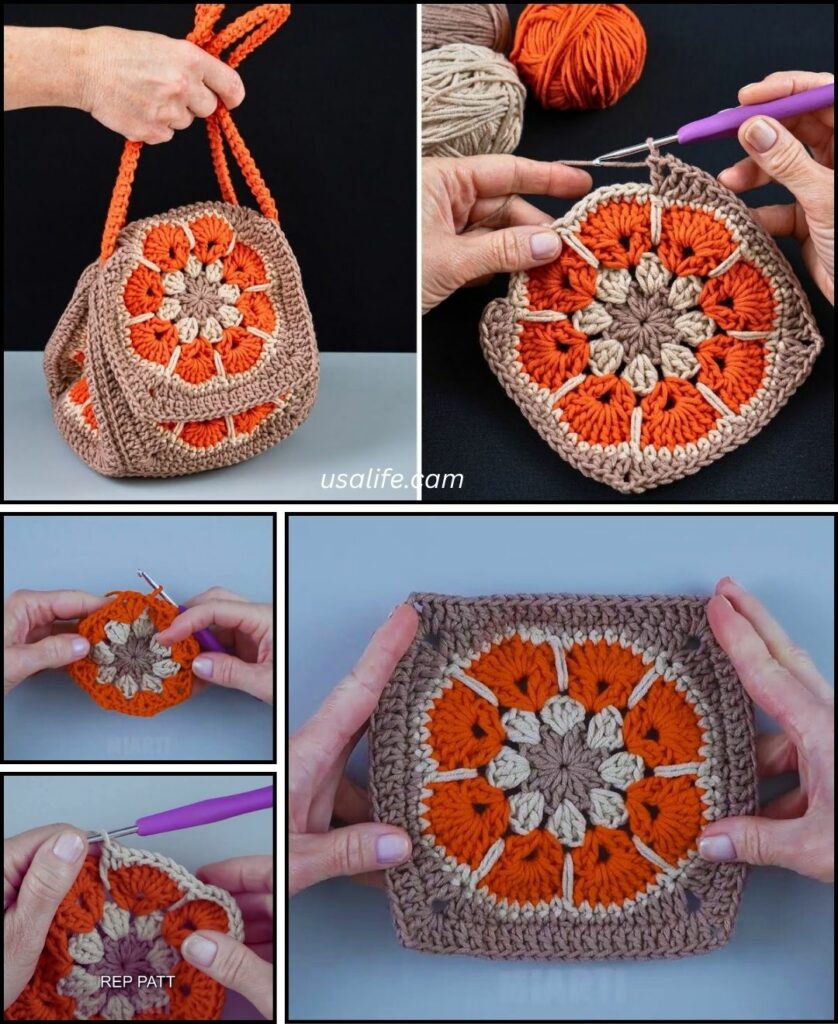
7. Finishing Your Crochet Granny Square Bag
- Weave in All Remaining Ends: Double-check every part of your bag for loose yarn tails. Weave them in thoroughly and securely.
- Blocking (Optional but Recommended): For a more structured bag, a gentle steam block or wet block can help even out your stitches and seams. Lay the bag flat (or stuff lightly with towels if it’s a structured tote), gently shape it, and allow it to dry completely. This is particularly helpful for ensuring the seams are straight and the squares are flat.
You now have a detailed guide on how to crochet a charming and functional granny square bag! Enjoy the process of bringing your unique design to life.

